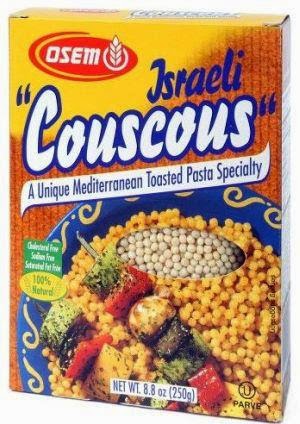A couple years ago, I was browsing the "ethnic foods" section in Albertson's. It's small because I live in a predominantly Caucasian area but I was pleasantly surprised to find some food stuffs I wasn't familiar with such as Israeli couscous. Naturally, I bought a box to try out. Israeli couscous is larger in diameter than what most people are used to because it's not true couscous; it's made from hard wheat and is more like pasta. Created during the "austerity" period in Israel, 1949 to 1959, "ptitim" was developed as a substitute for rice. I like Israeli couscous because it's sturdier than some of the smaller pastas like orzo and even better, it doesn't clump. It remains fluffy rather than merging into one dense mass in the bottom of the bowl. Ptitim also has a chewier texture so if texture is an issue for you, don't even bother. Seriously.
This is yet another recipe which I threw together late one night for a family dinner the following day, so it's been recreated as well as I can.
Ingredients:
1 box of Israeli couscous, cooked according to the directions on the box
1 cucumber, peeled and diced
3 medium tomatoes, diced
quarter cup or so of sliced kalamata olives
half cup or so of crumbled feta cheese
half a red onion, diced
juice from 1 lemon
quarter cup or so of good olive oil
2 TBSPS or so of fresh dill, minced
salt and pepper to taste
Cook couscous according to the directions on the box OR boil 2 cups of water with a pinch of salt, add 1 1/4 cups of Israeli couscous, bring back to a boil, cover, turn down to a simmer and cook 8 to 10 minutes. Don't drain--all the liquid should be absorbed. Let cool. Put in a large bowl and add the rest of the ingredients. Mix thoroughly, taste, and adjust seasonings accordingly.
Cook's Notes:
1. Seriously, use FRESH dill and FRESH lemon juice for the dressing. If you don't, may the fleas of a thousand camels infest your underwear. Neither item is very expensive and the dill will last a couple weeks if you keep it in its original packaging and store it in the fridge.
2. When I tell you to taste and adjust your seasonings, there's a couple reasons for it. One is because seasonings added at different points in cooking taste different. Fresh pepper loses its bite when added at the beginning stages of a dish whereas if you add it at the end of cooking or right before serving the dish, you're able to appreciate to taste and appreciate the flavor. Dried herbs need to be added earlier in the cooking process in order to extract their full measure of flavor and fresh herbs are used more as a garnish or a finishing touch otherwise they lose all their brightness and taste.
Another reason you need to taste and adjust is because taste is subjective. What I like is not necessarily what you like. You're making the recipe, you make it taste how you want it to taste.


